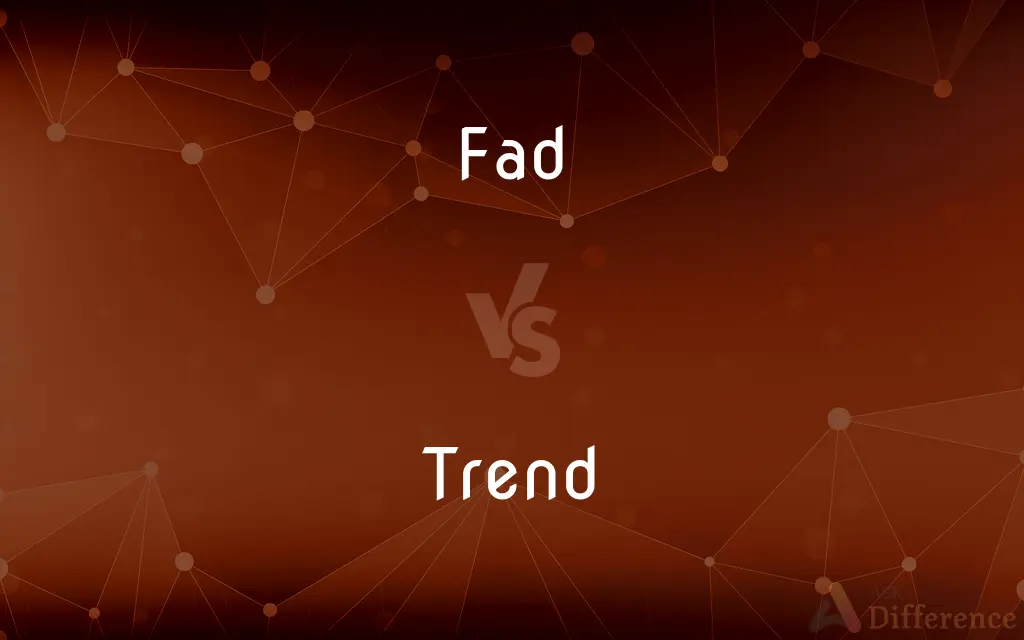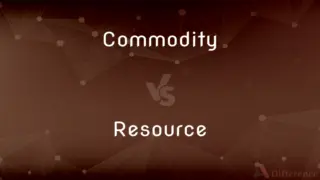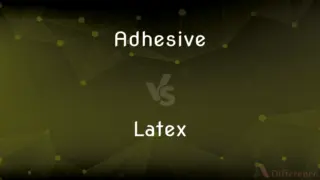Fad vs. Trend — What's the Difference?
By Tayyaba Rehman & Fiza Rafique — Updated on September 16, 2023
A "Fad" is a short-lived, intense popularity or enthusiasm for something, often driven by emotional excitement rather than intrinsic value. A "Trend" is a more enduring, generally longer-lasting shift in behavior, opinion, or style with a broader impact.

Difference Between Fad and Trend
Table of Contents
ADVERTISEMENT
Key Differences
A "Fad" is something that gains quick popularity but loses it just as quickly. These phenomena often capture the public's imagination for a brief period, frequently fueled by media hype or viral marketing. A "Trend," on the other hand, is a longer-lasting pattern or direction in which something is developing or changing. Trends often reflect underlying shifts in consumer needs, attitudes, or behaviors.
"Fads" often manifest in consumer products, fashion, diets, and even in investment decisions, capturing people's attention rapidly but often disappearing after a short time. "Trends" tend to be more stable and can be seen in broader societal changes, like attitudes toward sustainability, technological adoption, or shifts in work habits.
In terms of duration, a "Fad" usually has a life cycle that can be as short as a few weeks to a few months. "Trends" typically last much longer, sometimes even decades, making them more reliable indicators of longer-term shifts in behavior or taste.
From a linguistic perspective, both "Fad" and "Trend" function as nouns but carry different connotations. "Fad" often carries a somewhat negative connotation, implying lack of staying power and superficiality. "Trend," however, has a more neutral or positive connotation, often indicating a meaningful, longer-lasting change.
Comparison Chart
Duration
Short-lived
Longer-lasting
ADVERTISEMENT
Impact
Limited, intense
Broader, gradual
Cause
Emotional, hype
Underlying shifts
Connotation
Often negative
Neutral or positive
Grammatical Role
Primarily Noun
Primarily Noun
Compare with Definitions
Fad
A temporary fashion or mannerism.
Low-rise jeans were a fad in the early 2000s.
Trend
A prevailing tendency or inclination.
Sustainable fashion is a positive trend nowadays.
Fad
A short-lived craze or enthusiasm.
The fidget spinner was a fad that faded quickly.
Trend
A pattern of change over time.
The trend in smartphone design is toward larger screens.
Fad
Something that is popular for a short time.
The paleo diet was a health fad that had its moment.
Trend
A widespread change in behavior or attitude.
Mindfulness is a trend that has gained lasting traction.
Fad
A burst of public interest that is brief.
The Dalgona coffee fad swept social media for a month.
Trend
A general tendency or course of events
A warming trend.
Fad
A practice or interest with short-lived popularity.
The mannequin challenge was a fad that entertained many.
Trend
Current style; vogue
The latest trend in fashion.
Fad
A fad, trend, or craze is any form of collective behavior that develops within a culture, a generation or social group in which a group of people enthusiastically follow an impulse for a short period. Fads are objects or behaviors that achieve short-lived popularity but fade away.
Trend
The general direction of something
The river's southern trend.
Fad
A fashion that is taken up with great enthusiasm for a brief period of time; a craze.
Trend
To show a general tendency; tend
The magazine's circulation is trending downward.
Fad
A phenomenon that becomes popular for a very short time.
Trend
To undergo a rapid increase in public interest or attention
News of the earthquake is trending on social media.
Fad
A hobby ; freak; whim.
It is your favorite fad to draw plans.
Trend
To extend, incline, or veer in a specified direction
The prevailing wind trends northeast.
Fad
A practise followed enthusiastically by a number of people for a limited period of time; as, the latest fad in fashion.
Trend
An inclination in a particular direction.
The trend of a coastline
The upward trend of stock-market prices
Fad
An interest followed with exaggerated zeal;
He always follows the latest fads
It was all the rage that season
Trend
A tendency.
There is a trend, these days, for people in films not to smoke.
Trend
A fad or fashion style.
Miniskirts were one of the biggest trends of the 1960s.
Trend
(mathematics) A line drawn on a graph that approximates the trend of a number of disparate points.
Trend
(nautical) The lower end of the shank of an anchor, being the same distance on the shank from the throat that the arm measures from the throat to the bill.
Trend
(nautical) The angle made by the line of a vessel's keel and the direction of the anchor cable, when she is swinging at anchor.
Trend
Clean wool.
Trend
(intransitive) To have a particular direction; to run; to stretch; to tend.
The shore of the sea trends to the southwest.
Trend
(transitive) To cause to turn; to bend.
Trend
To be the subject of a trend; to be currently popular, relevant or interesting.
What topics have been trending on social networks this week?
Trend
To cleanse or clean (something, usually wool).
Trend
To have a particular direction; to run; to stretch; to tend; as, the shore of the sea trends to the southwest.
Trend
To cause to turn; to bend.
Not far beneath i' the valley as she trendsHer silver stream.
Trend
To cleanse, as wool.
Trend
Inclination in a particular direction; tendency; general direction; as, the trend of a coast.
Trend
Clean wool.
Trend
A general direction in which something tends to move;
The shoreward tendency of the current
The trend of the stock market
Trend
General line of orientation;
The river takes a southern course
The northeastern trend of the coast
Trend
A general tendency to change (as of opinion);
Not openly liberal but that is the trend of the book
A broad movement of the electorate to the right
Trend
The popular taste at a given time;
Leather is the latest vogue
He followed current trends
The 1920s had a style of their own
Trend
Turn sharply; change direction abruptly;
The car cut to the left at the intersection
The motorbike veered to the right
Trend
A general direction in which something is developing.
Remote work is a growing trend in various industries.
Trend
A long-term shift in public interest.
Electric cars are a trend that is likely here to stay.
Common Curiosities
What is a Fad?
A Fad is a short-lived craze or enthusiasm for something.
What is a Trend?
A Trend is a longer-lasting general direction in which something is developing or changing.
Does a Fad have a broad impact?
No, a Fad generally has a limited, intense impact.
How long does a Fad typically last?
A Fad usually lasts for a few weeks to a few months.
Is a Trend driven by underlying shifts?
Yes, Trends are often driven by underlying shifts in consumer needs or behaviors.
Is a Trend usually positive?
The term "Trend" usually carries a neutral or positive connotation.
How long does a Trend typically last?
A Trend can last for months, years, or even decades.
Is a Fad driven by emotion?
Yes, Fads are often driven by emotional excitement and media hype.
Does a Trend have a broad impact?
Yes, a Trend generally has a broader, more enduring impact.
Can a Fad turn into a Trend?
In some cases, what starts as a Fad may evolve into a Trend if it gains long-term relevance.
What’s an example of a Trend?
The use of renewable energy sources is a long-term Trend.
What’s an example of a Fad?
The Ice Bucket Challenge was a Fad aimed at raising ALS awareness.
Is a Fad usually negative?
The term "Fad" often carries a somewhat negative connotation.
Can a Trend start as a Fad?
Yes, some Trends may initially manifest as Fads before gaining long-term significance.
Are Fads and Trends always distinct?
While they are generally distinct, some phenomena can transition from being a Fad to becoming a Trend.
Share Your Discovery

Previous Comparison
Commodity vs. Resource
Next Comparison
Adhesive vs. LatexAuthor Spotlight
Written by
Tayyaba RehmanTayyaba Rehman is a distinguished writer, currently serving as a primary contributor to askdifference.com. As a researcher in semantics and etymology, Tayyaba's passion for the complexity of languages and their distinctions has found a perfect home on the platform. Tayyaba delves into the intricacies of language, distinguishing between commonly confused words and phrases, thereby providing clarity for readers worldwide.
Co-written by
Fiza RafiqueFiza Rafique is a skilled content writer at AskDifference.com, where she meticulously refines and enhances written pieces. Drawing from her vast editorial expertise, Fiza ensures clarity, accuracy, and precision in every article. Passionate about language, she continually seeks to elevate the quality of content for readers worldwide.
















































